Coffee Can Foundry
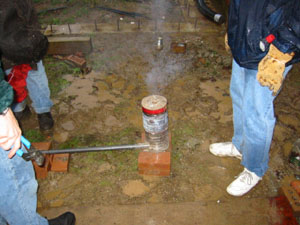
|
Coffee-can foundries are suitable for melting small
quantities of low melting point metals like zinc or
aluminium alloys. Having one is like having the
Easy-Bake oven of doom in your backyard!
|
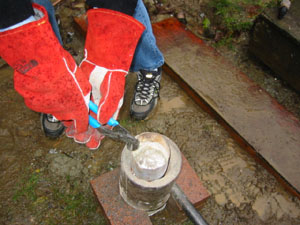
|
The basic idea is you use air forced over burning charcoal to
heat up your foundry and melt down metal in your
crucible. Then you can pour the liquid metal into a previously
prepared mold, let it cool, and you have your metal cast part.
|
A Little Background
While not the first to build one, David Gingery popularized backyard
casting with his series of books on building a home metal shop from
scratch. Even if you don't intend to build a foundry of your own I
highly recommend his book
The Charcoal
Foundry available from Lindsay Publications Inc. The book is
cheap, well written, and is covers everything you will need to know
to build a simple backyard foundry and cast some simple parts from
metal.
The earliest reference to a coffee can foundry I have found was and
article in The Journal of the Home Metal Shop Club of Huston, Texas,
Volume 2, Number 5, back in 1997. Gordon Lawson's article
A Miniature Foundry
gives a basic description of a building a single use aluminium foundry from common household
supplies.
For other cheap coffee can foundry designs I recommend looking W. E. John's
Metalcasting pages on his "Gizmology"
web site and "Jim's
Coffee Can Foundry
pages. Either of these designs should service for a couple
of small melts before having to be rebuilt or thrown away.
All of the previously mentioned foundries were designed to be
cheap. Most will cost less then $20-$30 to build and fire for the
first time. Their designers intended them only as an introduction to
metal casting. After building one of these foundries I would
seriously recommend ordering David
Gingery's The
Charcoal Foundry book. That said if you are willing to spend a
little money for a real crucible and refractory material, for about
$100-$200 you can build a something that should run 100 or more
melts.
Building the Foundry
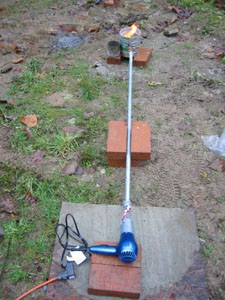
|
|
The foundry is charcoal fired. A hair-dryer is used to force air over
charcoal briquettes. After the briquettes heat up the foundry walls you can
put a crucible into the foundry and start melting some metal. Since the
hair drier is plastic I used a long pipe to force the air into the foundry.
The length of the pipe allows the pipe to cool before it comes into contact
with the plastic.
|
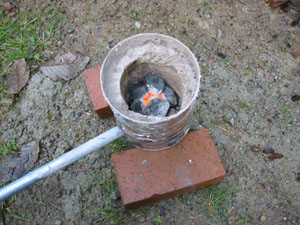
|
|
The walls of the foundry were made from a mixture of
Perlite and watered down chimney cement. The chimney
cement was about $20 and the Perlite was about $5 for a
giant bag. Buying a commercial refractory, which I did
for my later and larger foundry, cost about $50. The
metal coffee can provides a ready made form for the
slurry. After letting it dry for 24 hours I force dried
it with a charcoal run.
|
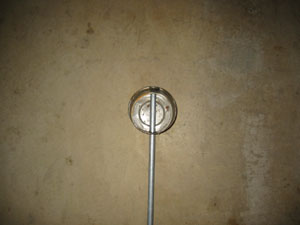
|
|
I started by cutting a hole in the base coffee-can and measuring and laying
out the air pipe for the flue. When you add the slurry to cast the walls of
the foundry you keep the pipe a little farther inside the coffee can in order
to act as a form. Once the refractory dries the pipe can be withdrawn forming
the flue.
|
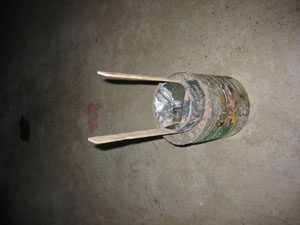
|
|
In the Gingery book they
recommend a cool collapsible core that you can dismantle once the walls of the foundry
are dried. In retrospect hat would have been a better idea. I chose to use strips of
wood taped to either side of a can as the interior form. Once the walls had dried
the strips allowed me to be able to remove the can. The problem was that the core
stuck to the walls and broke off the top of the inner lining while being removed.
In order to keep the temperature inside the foundry as
high as possible, and increase our overall fuel
efficiency, you want to make the foundry with a
lid. The lid should have a vent hole to vent the
exhaust gasses using the same refractory slurry used in
casting the walls.
|
Skimming the Dross
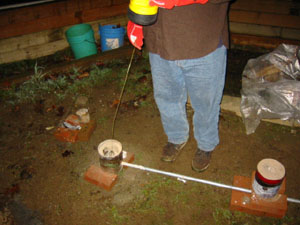
|
|
As the metal was melting we poked it periodically with a long piece of wire. The chunks
of metal go soft on the inside first like chocolate on a hot day. So to speed up the
melt we would push the plastic metal down into the hotter part of the crucible.
So what is with the flashlight? Well we by the time this melt got going it had
gotten dark. I really recommend not trying to pour at night. It just makes everything
more dangerous then it already is. The camera flash illuminated the scene but absent
that the only thing we could see was the glow of the coals and whatever was in the pool
of light lit by the flashlight.
|
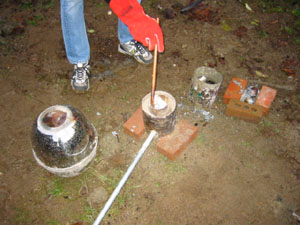
|
|
I use a section of pipe to skim the top of the molten metal in order
to skim the dross. Pennies tend to build up a lot of dross and I would recommend
you buy some zinc from a dealer if you plan on doing a lot of casting. Actually, I
suggest you skip straight to casting 6061 aluminum. It is not that much harder to
cast and it provides far superior casting.
By "squeezing" the dross skimmed from the top of the molten metal against the side
of the crucible you are able to drastically reduce the amount of metal lost during
skimming.
|
Pouring Ingots
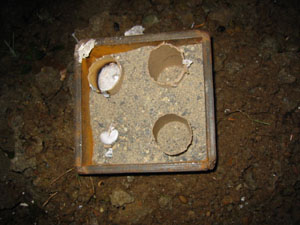
|
I suggest your first castings are nothing more than ingots. Basically,
metal poured into a simple open mold. After casting you want to be
able to pour off your excess metal as ingots to store until your next
casting session.
|
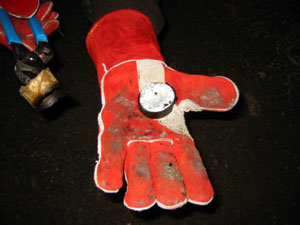
|
For my first pour I wanted to melt some Zinc and cast an ingot. I wanted to
use Zinc as it has a relatively low melting point and is easily obtained in
small quantities by melting American Pennies. My first molds were just sections
or toilet paper rolls pushed down into sand.
|
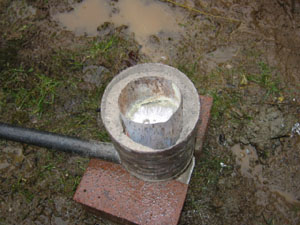
|
While the sand molds are an easy first mold they
tended to get a lot of crud mixed into the ingots
as you can plainly see in the picture. For later
pours I bought a miniature muffin tin at the
grocery store and bought some 1" aluminum rod to
melt down and recast. It was simple and worked
well and I highly recommend it.
|
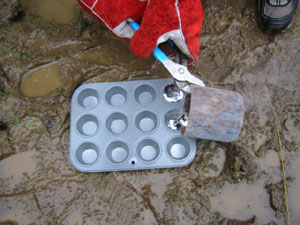
|
If you do use a muffin tin for an ingot mold,
which worked fairly well, just make sure that you
get one without any Teflon or other stick
resistant coating as it burns off and stinks like
hell.
|











